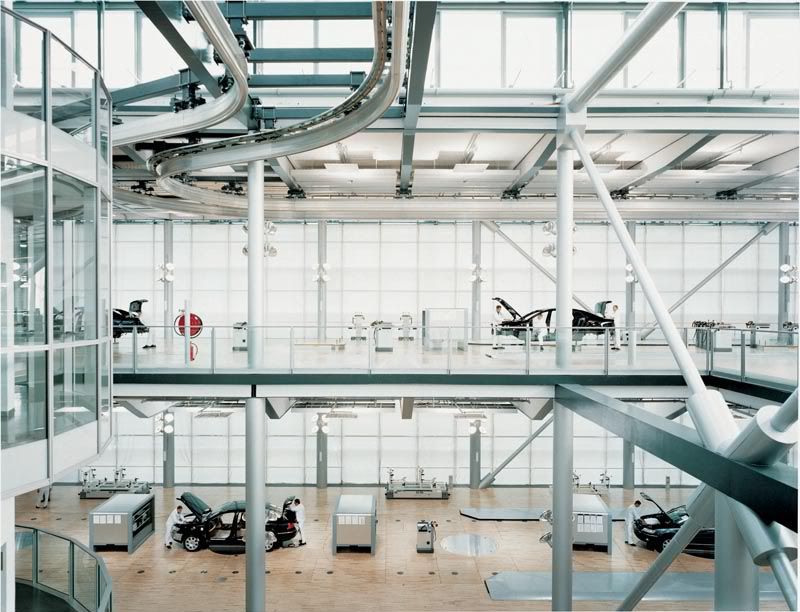GROUP 1: Frame Construction
Building: Gläserne Manufaktur or the Transparent Factory
Constructed: 2001
Architect: Gunter Henn
Location: Dresden, Germany
Client: VW Group

Factories do not have to be dark, dank, depressing places were hoards of people go to have their souls and individuality slowly whittled away. Consider VW's famed Gläserne Manufaktur or Transparent Factory. Gunter Henn, the architect of VW's Autostadt, creates a new idea for a factory, a light and airy place where craftsmen and women can feel like they are creating instead of just assembling as is fitting for the place where Volkswagen brand's most prestigious model, a $90,000 limousine that took over 10 years to design, is born. It is a place for architectural art to produce mechanical art. What makes this building remarkable (that factor that gives it its significance, its importance) is that it is just factory. This is not some museum, business headquarters, or showcase for public viewing. It is an industrial building where manufactoring takes place. They build cars here. People work here. That is why it matters. It challenges our perspective of what an automobile factory is. It shows us what manufacturing can be, what it be. It as if Gunter Henn took a normal factory with its simple frame construction and ripped its covering off to reveal and revel in its hidden structure and then places it in the middle of an art capital of Europe. Somewhere in that sequence, the factory became a piece of public art. The manufactory process becomes visible, it is on display for all. The building captures a certain clarity, a cleanliness, an honesty of intent. All is visible here. As such, the building’s becomes of paramount importance. The frame construction allows for the expressive glass walls and wide open spaces. The structure allows for the building to be “hung” upon it which opens the possibility for those glass walls. In fact, I would argue that the significance of the Transparent Factory is not its exterior façade, but the art of its structure. The glass exterior is there to allow the interior to be shown and there are no attempts to hide the building posts, beams, or x braces. If anything, they are intentionally on display and they should be. They are part of architecture and part of the art.




Building: BMW Welt
Constructed: 2007
Architect: Coop Himmelb(l)au
Location: Munich, Germany
Client: BMW AG

In keeping with the theme of German automakers, we next move to a project by Volkswagen Group’s Bavarian neighbors, BMW AG’s BMW Welt or World. While the Transparent Factory exposes its structure as part of its meaning, this chooses a different approach. For the most part it hides its structure and uses to craft seemingly impossible shapes and overhangs. It is a technical marvel that seems to be supported by just a few columns and fragile glass. Its importance does not lie in its striking and awe inspiring appearance, but in its genius of construction. It is space and form taken to its illogical conclusion. The architects have taken a structure and twisted, prodded, and pulled it into something new. This technical acumen is more than fitting for a company famed for its innovation, for a company that has brought us jet engines and turbochargers, but has famously conservative exterior designs. Of course, this building is anything, but conservative and it owes that to its structure. This building is only possible because its uses a space frame construction. Those exaggerated overhangs, all those impossible curves and balconies, that heavy roof supported by a few poles and some glass, and the fantastic double glass cone are all the product of careful structural engineering through the use of space frames. The building is exuberance through technicality, art through science. That is the genius of space frames. Space frames are structures that can be shaped into an artful piece of architecture because they are inherently strong. It is hearkening back to BMW’s mantra of producing the “ultimate driving machine”. Still a machine, but still very emotional. The structure is like the components that go into a car that you do not see. It is what makes the building possible and what gives it its personality. A BMW is nothing, but a pretty shell without its mechanical components, without its heart and this building would be nonexistent without the genius in construction. It supports itself with its structure. It is made of its structure.







No comments:
Post a Comment